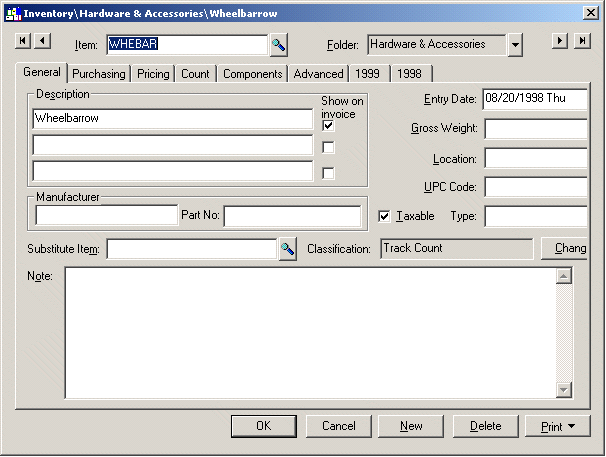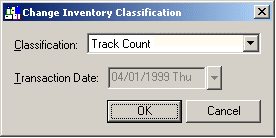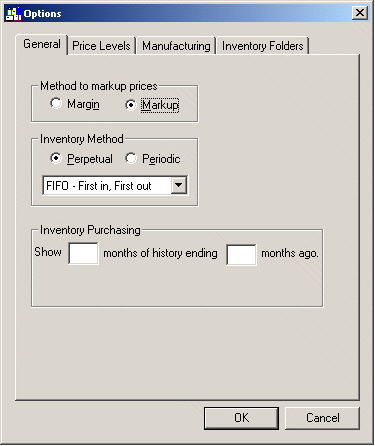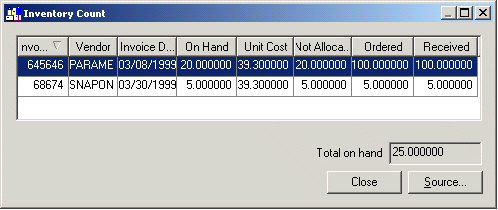
EBMS has many features to assist in accurately tracking the count on hand of each inventory item. This feature may be needed for some items but not for others. If you wish to track the count of some inventory items continue with this section. If not, you can skip the entire Tracking Inventory Counts section. An item must be classified as a Track Count item to maintain a current count of the items on hand. This classification is set by going to Inventory > Inventory Items > General tab.


EBMS is able to process inventory in a number of different ways. How your company handles this should be discussed with management and your tax advisor. EBMS can handle inventory on a periodic or perpetual basis. When perpetual inventory is chosen either FIFO or LIFO method of valuing inventory can be selected.
Periodic
Inventory is counted manually at set times throughout the year. For many companies, it is counted once at the end of the year or very close to the end of the year. After the count is complete, a journal entry is used to adjust the inventory asset account accordingly. The difference will go to an inventory change account. The disadvantage of periodic inventory is that the financial statements do not reflect inventory value changes between inventory counts. Within months when more inventories are purchased than the amount sold, the profit and loss statements would show a loss. The opposite would happen when the total amount of inventory decreases during a given period.
Perpetual
Inventory is tracked as it is bought and sold. This means that as items are purchased, the inventory amount is increased, and when the items are sold, the counts are decreased. The value of the inventory is adjusted in real time facilitating more accurate profit and loss statements.
There are two different ways that EBMS will value inventory when using the perpetual method: The first is called FIFO (First In First Out) while the second is called LIFO (Last In First Out).
FIFO (First In First Out)
This method means exactly what it says. The oldest inventory is sold before the items purchased recently. LIFO assumes your are rotating stock which means that items purchased last week are sold before items purchased yesterday.
LIFO (Last In First Out)
This method means that inventory is sold by newest to oldest items. Items purchased yesterday are sold before items purchased last week. To set the Inventory method go to Inventory > Options > General tab and the Options window will open:

Notice that when the perpetual method is selected, the drop down box becomes enabled and the FIFO or LIFO can then be chosen. When the periodic method is checked, the drop down box is disabled. In the example above, the perpetual inventory method is checked using the FIFO valuation.
FIFO (First In First Out) valuation method means that the first hammers that are bought are the first ones sold. An example would be: you bought 5 hammers on April 1 for $10.00 each, and on April 3 you sold 2 hammers. You now have 3 hammers at $10.00 each. On May 11 you buy five more hammers for $11.00 each. You now have 8 hammers, 3 at $10.00 each and 5 at $11.00 each. On May 15 you sell five hammers. What is taken out of inventory is three at $10.00 and 2 at $11.00. You have three at $11.00 left. The window below will show how inventory count for the item hammer looked on May 11:

Open this window by going to Inventory > Inventory Items > Count tab and double clicking on the Count field. This is a drill down window and shows the layers of inventory that are considered on hand using the FIFO valuation method. The fact that you count inventory this way does not mean that the items have to physically flow in this manner. The physical flow of inventory may or may not flow in the manner inventory is valued. This is not an important issue in determining your inventory valuation method.
LIFO (Last In First Out) valuation method means that the last hammers that are bought are the first ones sold. An example would be, you bought 5 hammers on April 1 for $10.00 each, on April 3 you bought 5 more hammers for $11. On May 11 you sell 2 hammers. You now have 8 hammers 5 at $10.00 each and 3 at $11.00 each. The window below will show how inventory count for the item hammer looked on May 11.

Open this window the same way as the one from the FIFO example above. Notice that the difference is that with LIFO (above), all the hammers are left from the first purchase date and only three from the last purchase date. In the FIFO window (2 above) you have all the hammers left from the last purchase date and only three from the first purchase date. This is called inventory layers. This can be calculated manually if using periodic inventory. EBMS will do this automatically, as can be seen from the above windows, if perpetual inventory is selected.
You may wish to consult your tax advisor or financial statement consultant about how to do these valuations accurately.